Midnight Hour
I haven’t paid to see a midnight movie in a lonng time. I don’t even go to midnight madness screenings at film festivals. I don’t even watch DVDs at midnight in my crib. But I’m glad they’re happening and that people like going to them. If for nothing else than tradition’s sake.
Today’s midnight movie culture (if you want to call it that) may not have much of a relation to what it was in the `60s and `70s, when the phenomenon was festive and throbbing and influencing this and that mainstream filmmaker. Youth culture was turning everything upside down back then, and midnight movies were the cinematic component of this.
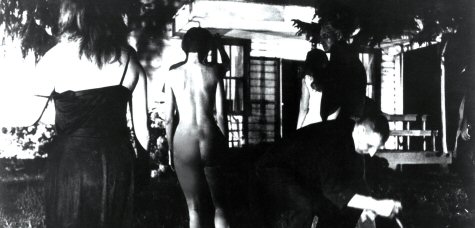
Zombie shuffle scene from George Romero’s Night of the Living Dead.
The difference is that today’s midnight screenings, however enjoyable they might seem to you or your friends, are about marketing. There are eclectic venues here and there — Seattle’s Grand Illusion cinema comes to mind — showing fringe stuff. But the feeling of grass-roots taboo-breaking and discovery has fallen away, for the most part.
It was de rigueur to get high before seeing these `70s films, partly (largely?) because they played better this way. I almost don’t want to see Greaser’s Palace or Putney Swope again because I don’t turn on any more and I don’t want to spoil memories of laughing my ass off, ripped, at the absurdist humor. Directed and written by the once-great Robert Downey Sr., these films never said to the audience, “This is funny — you’re supposed to laugh now.” Either you got it or you didn’t.
In any event, for those too young or insufficiently adventurous to have sampled this culture in its prime, there’s now an authoritative documentary by Stuart Samuels called Midnight Movies: From the Margin to the Mainstream.
< ?php include ('/home/hollyw9/public_html/wired'); ?>
It will air on Starz Encore sometime this summer, and maybe, says Samuels, in a theatre somewhere near you before that. It should play the midnight circuit, right? And there will be a long shelf life for the DVD, which will have all kinds of extras.
Midnight Movies is about the “hidden history” of six low-budget cult flicks — Alejandro Jodorowky’s El Topo, George Romero’s Night Of The Living Dead, Perry Henzell’s The Harder They Come, John Waters’ Pink Flamingos, Jim Sharman’s Rocky Horror Picture Show and David Lynch’s Eraserhead.
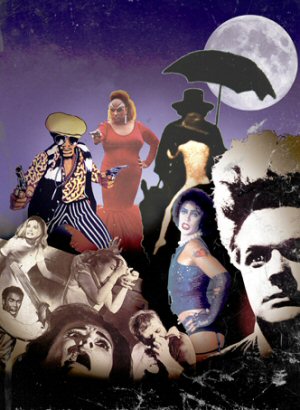
The reason these films played and played and played at theatres like New York’s Elgin, L.A.’s Fox Venice, Cambridge’s Orson Welles cinema and other such venues is that underground flicks were fairly exotic back then, and cineastes and stoners looking for a couple of skewed or outrageous hours in the dark had nowhere else to go.
Weird movies have since become corporatized, of course, and kids don’t go to theatres as much these days with DVDs and downloading and other distractions. But at least the midnight syndrome has kept on in some form. The ritual is well ingrained and people have a good time, and that’s great.
I sat down with Samuels during the Cannes Film Festival (where it played a couple of times) and talked about this $600,000 production, which he says was made for Mpix and Movie Central, the Canadian TV stations. Starz Encore has some kind of tie-in with these guys. And Telefilm, the Canadian government agency, paid for Samuels’ trip to Cannes, so they’ve got their fingers in also.
Samuels based the film on his own 1983 book, “Midnight Madness.”
“I taught film at ‘Penn’ (University of Pennsylvania in Philadelphia) in the `70s, and I wrote the book as my going-away present,” he says. “Things were changing, you could feel the chill as the `80s began, and I figured that 30 years hence people are not going to know what the midnight movie experience was all about.
“I knew there was something special about this group of films. So I sat down and wrote it as an academic, but there was another midnight movie book by Jonathan Rosenbaum and Jim Hoberman that came out four weeks after mine, and we wound up canceling each other out.
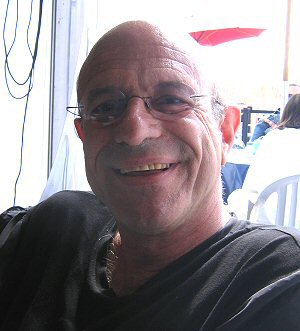
Stuart Samuels, director-writer of Midnight Movies: From the Margin to the Mainstream, at the American Pavilion during the Cannes Film Festival — Friday, 5.20, 11:20 am.
“Midnight movies are dead as a cultural phenomenon, but Rocky Horror is still doing business everywhere. It has always stayed because it deals with innocence and sexuality, and that is a constant that people can always relate to. It flopped when it first came out, but by the end of the `70s it was spelling the difference between profit and break-even for theatres and distributors everywhere. It’s earned about $200 million so far.
“The phenomenon is very circumscribed. It started at the end of the `60s with El Topo — that was really the first one. The films I’ve focused on in the film were handmade films, and they really changed film attitudes. But by 1980, Hollywood had co-opted it with cult films, and then video came along.
“It’s still being done now because it’s ritualized. The only new film to have been discovered by younger crowds was The Blair Witch Project, which took off because of the internet.
“I made this film for two reasons. One, we’re in the period of the end of something now. People are looking for something that’s more authentic, more direct…the young people like this film, but they didn’t know the story. And two, for older people, it contextualizes everything. I’m taking it to the heart of the enemy. I’m making a film about films that critics loved when they grew up.
“There are three elements to this story. The directors…the people who made these films. The theatre owners and distributors who showed them…Ben Barenholz, Larry Jackson, Bill Quigley. And the audiences. Like Bob Shaye, who went to El Topo at the Elgin. And I found a lot of interesting archive footage.”

Divine in a classic pose from John Waters’ Pink Flamingos
“I prescript everything. I know more about the subject than the interview subjects do. I know what’s inside that piece of stone. And I never use a narrator.
“The rights to the footage are clear. I know that morass. The only negotiation problem was with Fox. Rights are the reason no decent film can be made about the history of film. Documentaries about popular culture are going nowhere because the people who own all the rights, particularly the music rights…these people won’t give, nor will they deal on a reasonable basis. It’s insidious. One third of the budget on this film went to lawyers. This is why we get pap.”
Midnight Movies will show at the Silverdocs Festival in Silver Spring, Maryland, on 6.14. Samuels is also taking it to the Karlovy Vary Film Festival in the Czech Republic.
Hold On…
“I’d like to remind you that Reservoir Dogs had a midnight showing every Saturday for years at the New Beverly Cinema. Midnight screenings obviously haven’t died out. The rituals are not gone — they’ve just changed.
“Surely the persistence of a small theater called the Grand Illusion Cinema in
Seattle means something. They play lots of odd choices…at 11 pm. Where else in the world will Garbage Pail Kids (i.e., the movie) get screened? Or the 1980 Flash Gordon, or Yor, or Spawn of the Slithis?

“Don’t worry — they play good movies too. But the screenings I’ve been to have never been less than wild (Transformers: The Movie screened one night to a sold-out crowd) and a smell of absurdity always seems to permeate when an equally strange picture shows.
“Most midnight movies today are shown by the Landmark Cinema chain, but their choices are somewhat conservative compared to the Grand Illusion. Even so, it’s great to see old movies in a time when revival houses are nearly extinct.
“You have no idea how spoiled you are living in Los Angeles. LA, New York and Seattle are the last places in the US where you can see old movies in a theater. And any place where you can see an old movie is welcome these days.” — Gabriel Neeb.
Echo
The visual of the Martian hand grabbing the globe has always looked pretty cool to me. It’s rich and precise and makes its point.
The similarity to the design of the cover of the L. Ron Hubbard book is probably coincidental. I don’t know if Tom Cruise has it in his contract to approve or reject concepts for Paramount’s War of the Worlds one-sheet campaigns. I would be surprised if this were the case. Marketing execs tend to treasure their autonomy.
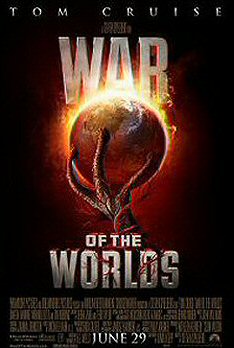
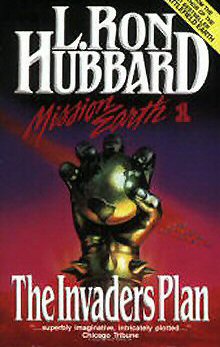
That said, it wouldn’t surprise me if Cruise, who is one of the film’s producers, didn’t have some kind of authority about the ad art. He is known for being exacting and particular about things. And we all know about the Scientology stand (or tent or whatever it was) on the set of War of the Worlds, which was seen by observers as a kind of recruitment attempt.
Without coming to any conclusions, it seems fair to at least take note of this. I mean, it does kind of pop out.
Silverado
I always smile when I think of Michael Cimino’s Year of the Dragon, which comes out on DVD on 5.31. Not because I liked this 1985 Chinatown-based crime film, which I found tediously crude and violent. I know I’ve never had the slightest desire to see it since, but it’s been twenty years so I guess I could let my guard down and give it another go.
Mostly I remember Mickey Rourke as a bullying racist New York police captain named Stanley White, and Cimino’s decision to streak Rourke’s hair with a lot of white, to go along with the name or something. It sounds trite, but that wasn’t the problem.
The problem was that Rourke’s hair changed color from scene to scene. It would be frosty white with dark streaks, and then grayish white and then blondish white and then brownish silver. It never seemed quite the same in any two scenes in a row.
And I smile because I’m always reminded of a term that former New York Times film critic Elvis Mitchell used to describe Rourke’s coif. He called it “mood hair.”
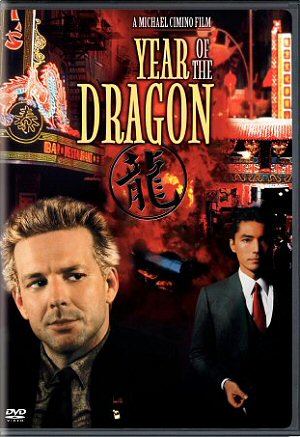
Those two words have been the foundation of my admiration for Mitchell ever since, no matter what gig he happens to be holding. (He’s an acquisition executive these days for Sony, and he might still be teaching at Harvard. I’d write him and ask, but he never answers back.)
Anyway, I intend to rent the DVD next week and take several digital photos of Rourke in different scenes in order to prove the point.
I’m also inviting Year of the Dragon‘s hair stylist Jon Sahag, who apparently tended to hair on only one other film, Michael Almereyda’s Najda, to get in touch and tell his side of the story and clear up any misconceptions.
Maybe Rourke’s hair was intended to change tints as a way of suggesting internal struggles or something.
Maybe F.X. Feeney, a longtime Cimino enthusiast, could get in touch and explain what he knows. I wrote him about this but it’s deadline time.
A reader named Joe Hanrahan has perked my interest on another front, without telling me exactly what he’s referring to.
Dragon, he says, “has at least one great scene. Rourke has left his wife for the Chinese news gal, and the scene starts with him sitting on their porch after a confrontation with her. Rourke goes back inside and notes that his wife has locked herself in the bathroom.
“Being a normal self-centered, guilt-infused male, my first thought as I watched was that she was committing suicide, but the scene takes a twist from there, and turns into one of the few mainstream movie scenes that have ever really shocked me.”
Kubrick Taschen
Instead of spending 10 bucks to see Adam Sandler stomp on prison guards this weekend, think about dipping into your slush fund and coughing up a portion for The Stanley Kubrick Archives (Taschen). Take it home and bolt your doors and let it seep in, page by lustrous page.
I’m so in love with the thing that I packed it in my suitcase earlier this month and hauled it all the way from Los Angeles to New York, and then up to my parent’s home in Connecticut. I almost took it with me to the Cannes Film Festival. It’s my best friend, my rock `n’ roll, my lump-in-the-throat. I haven’t felt this way about a mere possession in a long, long time.
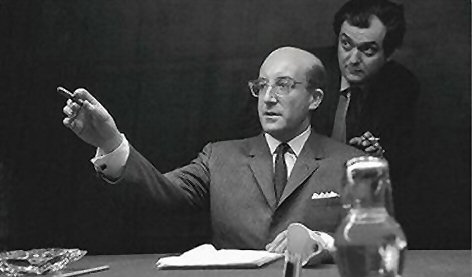
Stanley Kubrick (r.) directing Peter Sellers in his President Merkin Muffley guise on the set of Dr. Strangelove, or How I learned to Stop Worrying and Love the Bomb.
I’m not buying the claim on Amazon.com that this 544-page beast weighs 14.6 pounds. It felt like at least triple that when I was lugging it around Kennedy Airport.
The cost weighs pretty heavily too. 200 dollars, according to the Taschen website. But if you’ve ever thought about laying down serious coin for a first-rate coffee-table book, this might be the deal-maker. Besides, you can get it on Amazon for only about $125. I’ve blown $125 on things that I wasn’t all that thrilled about the morning after. I know I’m going to feel good about having this book twenty years from now.
Of course, you have to be a fool for Kubrick’s films in the first place. You have to get the Kubrick thing altogether, which means not just worshipping Paths of Glory or Dr. Strangelove or admiring most of Barry Lyndon, but also coming to terms with Eyes Wide Shut, which wasn’t easy at first but I got there.
I did this by facing up to the fact that resistance was futile. I’ve watched that red-felt pool table scene when Sydney Pollack explains the facts to Tom Cruise over and over, and I don’t even know why exactly…it’s like voodoo.
I presume this same susceptibility has enveloped most of the readers of this column.
The Archives text — articles, essays, interview excerpts, all kinds of data — has been edited and assembled by Alison Castle. It’s all smart, elegant and informative stuff, but this is par for a book of this size and scope from Taschen, the Rolls Royce of prestige publishers.

It’s the purely visual stuff that does it to you, in a strategy that mirrors that of Kubrick’s films. There are something like 1600 images in this thing — 800 immaculate frame blowups from all the films, and another 800 behind-the-scenes stills and various “items” (drawings, script notes, letters), most of which have never seen before. Plus essays by Kubrick scholars Michel Ciment, Gene D. Phillips and Rodney Hill
There are two keepsakes in The Stanley Kubrick Archives that are nearly worth the price alone: a twelve-frame film strip from a 70mm print of 2001: A Space Odyssey, taken from a print in Kubrick’s private vault, and a CD containing a 70-minute audio interview with Kubrick by Jeremy Bernstein in 1966…when Kubrick was at the summit of his powers.
All through my first reading I was feeling envious of Castle, who was given complete access by Kubrick’s widow, Christiane, and his longtime producer and brother-in-law, Jan Harlan. What an amazing job she had for two or three years.
All those details, all that minutiae…and she and the Taschen editors only got one little thing wrong. I’m referring to a photo taken on the Spartacus set that identifies costar Rudy Bond (who played a loud-mouthed gladiator, although for some reason this role isn’t listed on his IMDB page) as the film’s producer, Edward Lewis. There’s a very slight chance I’m wrong about this (Lewis may have been a dead ringer for Bond), but I doubt it.
This is a spa book…something to sink into and be replenished by. And yet it’s not quite the ultimate down-to-the-bone Kubrick book of all time. It’s more the ultimate Kubrick massage…a thinking person’s pleasure cruise…a first-class voyage into a very sumptuous and particular world.
It’s been called the most comprehensive book on Kubrick thus far. It is that, but in a selectively affectionate way.

Is it the most penetrating exploration of who Stanley Kubrick really was, and what his life and work finally amounted to, warts, missed opportunities and all? That’s not the intention here.
Does it explore the conflicts Kubrick had with Marlon Brando in the development of One-Eyed Jacks, which resulted in Brando firing him? I would have loved to have read something specific about this, but no.
Does it get into the specific clashes Kubrick had with Kirk Douglas over the making of Spartacus? Here and there, but not to any great detail.
The best books about artists should not only celebrate but dish some rude stuff here and there.
It’s been reported before that Douglas was offended by Kubrick’s pre-production suggestion that he, Kubrick, be given screen credit for Dalton Trumbo’s script, since Trumbo, it was assumed at the time, couldn’t be given this due to his blacklisted screenwriter status. (Douglas eventually gave Trumbo this credit, which helped to end the blacklist era.)
Was this the only reason that Douglas referred to Kubrick during a 1982 interview I had with him as “Stanley the prick”? Douglas was famously egotistical and a scrapper, but I always wanted to know more about his and Kubrick’s relationship.
I guess what I’m saying is that Archives would have been a tad more interesting if Castle and Kubrick’s family hadn’t been so fully committed to the late director’s perspective and had brought in a few naysayers or nitpickers for added flavor.
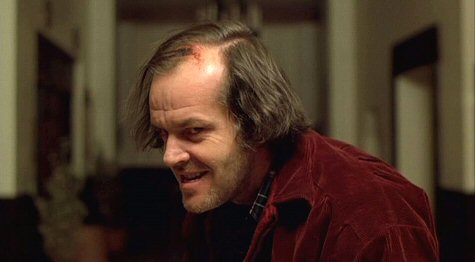
Does it take a hard look at Kubrick’s fastidious, increasingly isolated way of living and working, removing himself more and more from life’s rough and tumble as he got older…more exacting, more of an aesthetic unto himself? Again, not the shot.
Does it ponder the regrets and might-have-been’s and shortfalls? Somewhat, but family-sanctioned tributes are never about tough love.
It would have steered in this direction if I had been the editor. Not to take Kubrick down (I’m as much a fan as Castle or anyone else on the team) but to explore the ironies more fully. I’m saying I would have zeroed in on the paradoxical lesson of Stanley Kubrick’s life and career, which is that absolute creative control is not necessarily the glorious thing it’s cracked up to be.
The truth is that the more he became “Stanley Kubrick,” the more he ate his own creative tail. The political power Kubrick gained from the financial success and cultural esteem of Dr. Strangelove and 2001: A Space Odyssey in the 1960s, which led to the carte blanche support he got from Warner Bros. starting with the making of A Clockwork Orange, allowed him to follow his intrigues to his heart’s content, and this became both his salvation and his trap.
This is an old tune with me, but as watchable as his movies are and always will be, the more remote and mercurial Kubrick became the more his films became about stiffness and perfection. This is why I’ve always been more of a fan of his work from The Killing to A Clockwork Orange than the last 24 years of his career, during which he produced only four films — Barry Lyndon , The Shining, Full Metal Jacket and Eyes Wide Shut.
I realize that the emotional bloodlessness of Barry Lyndon is partly what makes it a masterwork, but you can’t tell me Kubrick’s personality wasn’t at least a partial ingredient in this.
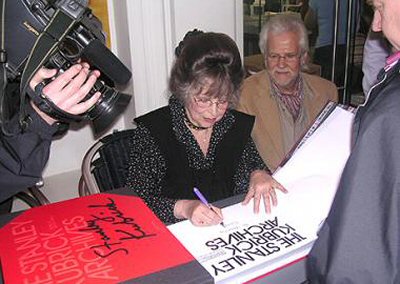
Christiane Kubrick signing copies of The Stanley Kubrick Archives a few days ago in London. Her brother Jan Harlan, who produced Kubrick’s later films, sits to her left.
The opening 20 or 25 minutes of The Shining are among the spookiest ever captured in any film (that interview scene between Jack Nicholson and Barry Nelson is sheer perfection) but the very last shot, the one that goes closer and closer into that black-and-white photo of Jack Nicholson’s character celebrating at an Overlook Hotel black-tie ball sometime in the 1920s, is one of the lamest epilogues ever…it’s metaphysical claptrap.
(I was one of the few who saw a version of The Shining with an excised scene between Nelson and Shelley Duvall that comes right before this shot — Kubrick cut it before the film went into general release. I don’t have the book with me as I’m writing this, but I don’t think it makes any mention of this last-minute edit.)
(And while we’re on the subject, it would have been really special if the book had included frame blowups from the reported five minutes or so from 2001‘s “Dawn of Man” segment that Kubrick trimmed out just after a critics preview. But it doesn’t.)
The labored dialogue in the Vietnam portions of Full Metal Jacket (like “I say we leave the gook for the mother-lovin’ rats” or “Am I a heartbreaker? Am I a…whoo-hoo!..life-taker?”) makes Jacket feel like some kind of stage production rather than something actually going down in that war-torn region in the late ’60s. I read somewhere that some of the actors (Adam Baldwin, for one) bitched behind Kubrick’s back about this, or maybe to his face…I don’t precisely recall.
And yet that final battle sequence (going after that female Vietcong sniper in Hue) is breathtaking.
Don’t get me started on Eyes Wide Shut, but Kubrick’s belief that he would get an R rating (which he was contractually obliged to deliver) for that mansion-orgy sequence footage indicated a man who had stopped taking the pulse of things outside his country estate.
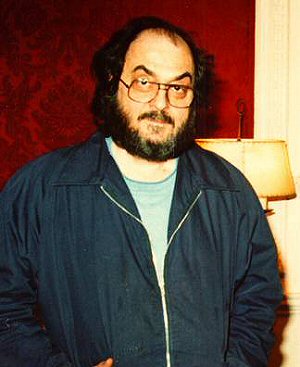
Kubrick at his home in January 1984, in a snap taken by a friend.
And yet for a guy hooked on visual fastidiousness and an increasingly misanthropic view of human affairs, Kubrick nonetheless made films that were tantalizing and seductive….each one a feast.
There’s a Kubrick quote in this book that I’m paraphrasing here, which is that the final measure of lasting motion picture art — all art — lies in the emotional.
It comes down to simple visual pleasures…the thought-out, strongly fortified kind that has led me to watch the Barry Lyndon DVD 15 or 20 times, even thought I don’t care very much for the funereal tone of the film’s second half. I sit through it because I love the Lord Bullington duel sequence and the final epilogue card that states, “Rich or poor, happy or sad, they are all equal now.”
I wouldn’t want to suggest that The Stanley Kubrick Archives is too softball. It is what it is, and that’s a hell of a thing.
The second half takes you in to Kubrick’s deliberative mind more thoroughly (i.e., more personally) than anything I’ve read. From the perspective of first-hand creative immersion, of recreating a world as the artist himself tried to know it and lick it as best he could, it’s one of the finest books on a film director ever published.
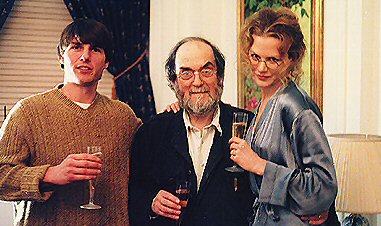
Tom Cruise, Stanely Kubrick, Nicole Kidman on the set of Eyes Wide Shut. It never occurred to me before reading this book that Kubrick was on the short side, or shorter than Cruise anyway.
Slightly Gentler Neil
I was so traumatized by the weakness of the dollar during my stay in London last Saturday through Tuesday that I was having anxiety attacks the whole time. I did a lot of speed-walking and visiting different internet cafes and questioning my dumb impulsiveness in flying there in the first place. I didn’t eat anything except fruit and coffee and fast food….awful.
And yet in the face of this I decided last Monday night to pop for a ticket to Neil Labute’s Some Girls, which opened a day or two later at the Gielgud. I’d missed Labute’s last two, Fat Pig and This Is How It Goes (which both played in New York), as well as The Mercy Seat and The Distance From Here, which I didn’t even know about until I read the program. Anyway, I needed to catch up.

Some Girls costars Catherine Tate, Saffron Burrows, David Schwimmer, Sarah Tate, Lesley Manville.
And I wanted to see how former Friends star David Schwimmer, who began on the Chicago stage, would handle himself in the lead role. Verdict: he’s relaxed and assured and does quite well.
He’s playing a nominally sensitive short-story writer who’s run away from relationships all his semi-adult life, and is now feeling a bit guilty about this as he prepares to get married. So he pays a visit to four ex-girlfriends in four different cities to talk things over and see if any of them are still pissed about being dumped.
He’s really looking to be forgiven or at least hear that he’s not so bad. This doesn’t happen. He gets a good stiff shot of reality from each ex.
Labute’s plays and films are usually about what pigs or weaklings men are in their relationships with women, and in this light the dealings in Some Girls aren’t as searing or corrosive as usual. It’s not lacking in emotional bruisings, but it’s not quite mild-mannered either.
And Schwimmer’s character makes an effort to at least talk a sensitive game when he catches up with the women. But who and what he really is — a serial escape artist — comes through soon enough, and at the end you feel for his young fiance (whom we never meet) because you know what she’s in for.
The one-act play is funny here and there, briskly paced (at roughly 100 minutes) and sometimes very biting. A moderately engaging piece. But it doesn’t build or develop all that excitingly and it basically leaves you with a “yeah, not bad” reaction. Is it a movie? No, but maybe an HBO or a Showtime thing.
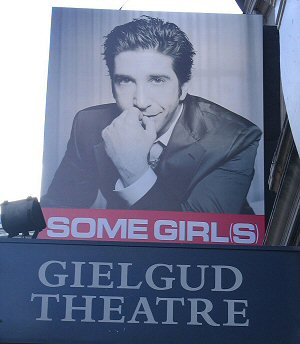
Schwimmer’s first visitation is in Seattle with Sam (Catherine Tate), whom he dropped just before the senior prom in high school. Married to a guy who works in a food store and raising kids, she’s still riled about what Schwimmer did (especially his having taken another girl to the prom) and having her emotions stirred.
Then there’s Tyler (Sara Powell) from Chicago, a randy easygoing type who needs a little time to remember what a bastard Schwimmer was to her…and then the anger catches fire.
In Boston he pays a call on Lindsay (Lesley Manville), a married woman he had an affair with behind her husband’s back, and who is also quite angry and looking for revenge.
Finally there’s Bobbi (Saffron Burrows) from Los Angeles, who is hurt but still cares for him…although she’s too smart and proud to open up a second time, even when he tells her she’s the love of his life.
The actresses are all sharp and on top of their roles, and each scene deftly reveals a surprise or two about their past relationship with Schwimmer. LaBute is a gifted writer and psychologically shrewd, but Girls is basically laying out Schwimmer’s history without adding anything urgent or present-tense to it.
Randomly
I was so upset by London I decided to get back to States as quickly as possible to take stock and lick my wounds. That meant flying Easy Jet from London to Amsterdam for the connection back home, and since I had a few hours to kill I decided to go into town and look around.
I don’t get high so the whole cannabis side of things didn’t hold any appeal, but it’s mildly startling to be in the Abraxas Cafe and see the wide variety of hallucinogenic brownies being sold. Amsterdam is cool but English is spoken so widely and there are so many Brits and Americans running around that the exotic appeal feels diminished for a European city.
It’s obviously more than just a party town for stoners, but that’s what it felt like during my three-hour visit. Stoners and flower markets (what exactly do you do with a tulip?) and prostitutes and Burger Kings.

Southern sector of Hyde Park near Lancaster Gate — Sunday, 5.22, 5:50 pm.

McDonald’s delicacy available primarily to Londoners.

Four or five blocks due south of London’s Piccadilly Square — Monday, 5.23, 4:45 pm.

Near London’s Sussex Gardens — Sunday, 5.24, 2:35 pm
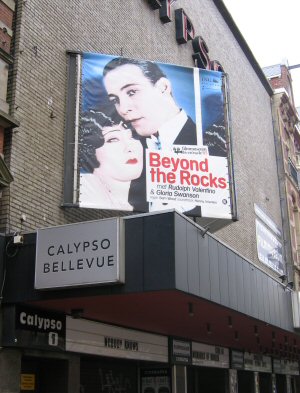
Valentino and Swanson at Amsterdam’s Calypso Bellevue — Tuesday, 5.24, 3:10 pm

Tuesday, 5.24, 5:05 pm.

Amsterdam — Tuesday, 5.24, 3:50 pm.

Tuesday, 5.24, 4:10 pm.

Tuesday, 5.24, 10:10 am.
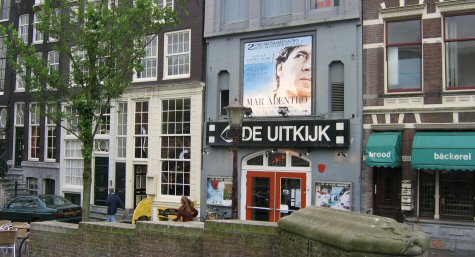
Canal-adjacent theatre in Amsterdam — Tuesday, 5.24, 3:05 pm.
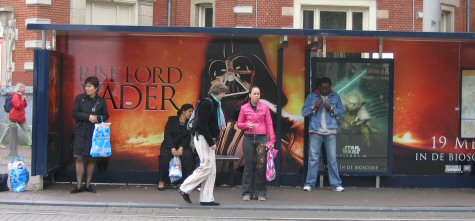
Amsterdam commuters — Tuesday, 5.24, 3:20 pm.
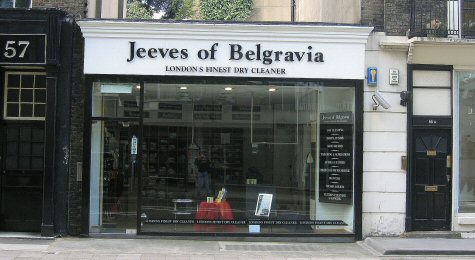
Near London’s Sussex Gardens — Sunday, 5.22, 2:15 pm

Residential street near London’s Sloane Square — Sunday, 5.22, 4:20 pm.












